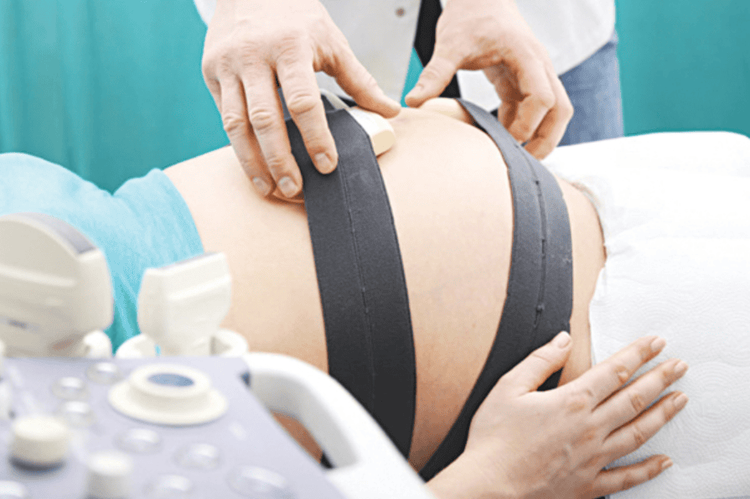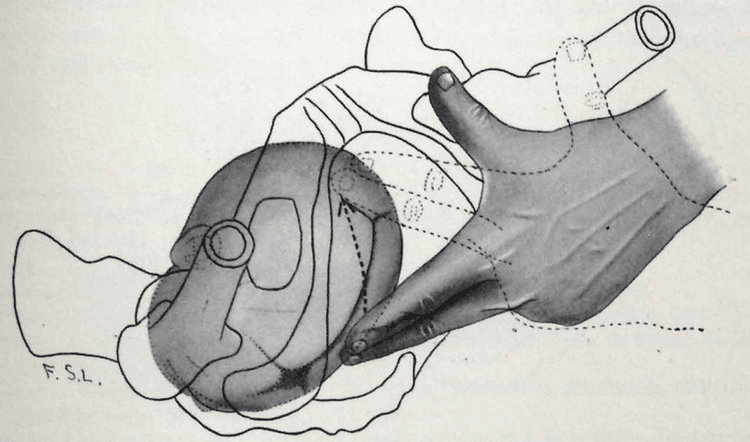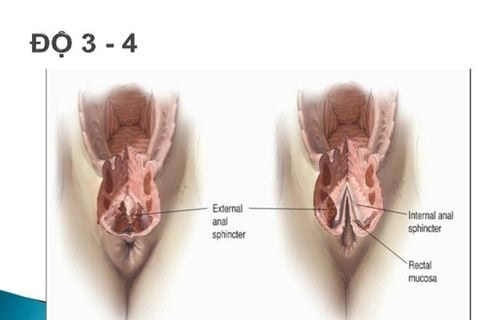This is an automatically translated article.
The article was consulted by Specialist Doctor I Pham Thi Yen - Obstetrics and Gynecology Department - Vinmec Hai Phong International General HospitalEvery woman goes through labor differently. Tracking the stages of labor helps the process go on safely and smoothly.
1. What is labor?
Labor is a progressive process of many phenomena, the most important being uterine contractions that make the cervix gradually dilate and as a result, the fetus and placenta are expelled.
Identify labor when there is a true uterine contraction, if there are 12 contractions / 1 hour, it is labor, the characteristics of true labor help distinguish it from false labor:
Regular contractions regular, painful. The interval between contractions shortens. The contractions gradually increase in intensity and duration. There is a relationship between contraction intensity and pain. Causes cervical dilation. The throne is down. Tocolytics do not stop contractions. Diagnosis of labor:
Colic pain. Pink vaginal discharge. Labor contractions. Cervical dilation. Establishment of the amniotic sac.

2. Stages of labor
The stages of labor include:
Stage 1: Cervical dilation, this period from actual labor until the cervix is fully dilated: the average time is 15 hours. This period is divided into 2 periods:
Latent period: 8 hours. Operating time: 7 hours. Stage 2: Pregnancy from the time the cervix is fully dilated until the pregnancy is delivered.
Compare: 30 minutes – 2 hours, average 50 minutes. Straw: 15 minutes – 1 hour, average 20 minutes. Stage 3: The placenta is delivered from the time the placenta is delivered to the time the placenta comes out for an average of 5-30 minutes.
Trắc nghiệm: Đặc điểm cơn đau đẻ và diễn biến cuộc chuyển dạ
Cơn đau đẻ là dấu hiệu thông báo sự chào đời của em bé. Cùng thử sức với bài trắc nghiệm sau đây sẽ giúp các bà mẹ mang thai nhận biết cơn đau đẻ và diễn biến cuộc chuyển dạ để chuẩn bị trước tâm lý những gì sắp xảy ra đối với mình.The following content is prepared under supervision of Thạc sĩ, Bác sĩ y khoa, Tạ Quốc Bản , Sản phụ khoa , Khoa Sản phụ khoa - Bệnh viện Đa khoa Quốc tế Vinmec Phú Quốc
3. Track the stages of labor
3.1. Whole-body monitoring Pulse: During labor, the pulse must be monitored every 4 hours to ensure early detection of abnormal pulse changes during labor and right after birth. Normal pulse 70 - 80 times/minute; Blood pressure: During labor, measure blood pressure every 4 hours if labor progress is normal. If there is bleeding or a rapid pulse, blood pressure should be measured more often; Temperature: During labor, measure body temperature every 4 hours, if labor is progressing normally; 3.2. Monitor uterine contractions Latent phase:
Manual uterine contractions: every 1 hour Average:
Contraction time: 20” Rest time: 3' – 4' Monitor by monitor, average Average 3 contractions / 10 minutes, intensity: 40 mmHg

Active phase:
Manual uterine contractions every 30 minutes Average:
Contraction time: 30'' - 40'' Rest time: 2' - 3' When the cervix is nearly full:
Average:
Contraction time: 40”–50” Rest time: 1’–1’30” Monitored by monitor, average 3 – 4 contractions/10 minutes, intensity: 60 – 100 mmHg. When the cervix is nearly full: average: 4-5 contractions/10 minutes, intensity: 80-100 mmHg
3.3. Monitor fetal heart rate In the latent phase: listen to fetal heart rate at least every 1 hour; in the active phase every 30 minutes. Listen to the fetal heart immediately after the rupture of membranes or before and after amniotomy; The time to listen to the fetal heart is outside of uterine contractions. At the stage of pushing, listen to the fetal heartbeat after each push; Count the fetal heart rate in 1 minute, comment whether the fetal heart rate is even or not? Normal: the average fetal heart rate is 120-160 beats/minute, regular and clear. Abnormal fetal heart rate when > 160 beats/min or < 120 beats/min or irregular. 3.4. Monitor amniotic fluid status: describe the shape of the amniotic sac (flat, bulging, pear) Broken water: spontaneously or amniotically arc ≥ 5 cm Premature rupture of membranes: when there is actual labor but untimely rupture of membranes Premature rupture of membranes: when there is no actual labor Amount of amniotic fluid: Normal: 500 – 1000 ml Polyhydramnios: > 2000 ml Oliguria : < 500 ml Amniotic fluid color : Milky white: normal Clear white: preterm pregnancy Yellow, green: signs of fetal distress Red-brown: stillbirth Odor of Amniotic fluid: Slightly fishy: Normal Stin : infection

3.5. Monitor the degree of cervical dilation It is necessary to limit vaginal visits to avoid infection; Vaginal examination every 4 hours in the latent phase, every 2 hours in the active phase, when membranes rupture and when deciding to push the woman. In case of rapid progress in labor, vaginal examination can be done to evaluate the cervix and position of the position; Latent phase lasts 8 hours: labor begins until the cervix is dilated 3cm; Active phase lasts up to 7 hours: from 3cm to 10cm dilation of cervix (fully dilated); Normally, the cervix is soft, thin, and not edematous. The cervical dilation curve on the labor chart is always to the left of the alarm line; Abnormal if: cervix is not progressive, edematous, curve of cervical dilation changes to the right of the alarm line or cervix is fully dilated without tipping; 3.6. Monitor the progress of the fetal position Monitor the progress of the fetal position by external manipulation of the abdominal wall and vaginal examination; Assess the progress of the throne: there are 4 levels: high, loose, tight, tight and tight. Once passed, there are 3 levels: high pass, medium pass and low pass Record the pass on the labor chart. Early detection of delayed labor; If the pregnancy does not progress, if it is at the commune level, it must be moved to a place where surgery is possible.
4. Taking care of pregnant women during labor
4.1 Nutritional latency period: Give pregnant women adequate nutrients to eat and drink. Personal hygiene: Provide clothes, sanitary napkins, paper underwear, tissues, instruct pregnant women on personal hygiene. Women who exercise gently except for the following cases: Infusion, premature rupture of membranes, pathology... Change the dressing regularly, observe the color of the amniotic fluid (for premature rupture of membranes) Inform the medical staff Abnormal signs (watery, vaginal bleeding) Instructions on how to breathe, push, and rest for pregnant women to control pain Medical staff are considerate, caring and helpful to help pregnant women feel secure, calm and safe. cooperate. 4.2 Stage of activity Nutrition: giving the mother porridge to eat Hygiene: Cleaning the vulva - perineum during examination and delivery Instructing how to breathe, push, and rest for pregnant women to control pain Medical staff considerate, caring and supportive health care provider to help pregnant women feel secure, calm and cooperative. 4.3 Postpartum period Nutrition: feed the mother porridge, drink milk, eat soup Personal hygiene: wipe the face, tie the hair neatly, clean the breast, clean the vulva-perine area, keep the birth canal clean, dry subject. For the mother: Medical staff guide breastfeeding, proper nutrition, exercise, breast and genital hygiene, and how to keep the perineal stitch clean and dry. For children: When the baby is born, it is warmed, monitored for urination, breastfed soon after birth to enjoy colostrum, placed the baby on its back with its head slightly elevated, with its face tilted to one side. At Vinmec International General Hospital, there is a package maternity service as a solution to help pregnant women feel secure because of the companionship of the medical team throughout the pregnancy. When choosing Maternity Package, pregnant women can:
The pregnancy process is monitored by a team of qualified doctors Regular check-up, early detection of abnormalities Maternity package helps to facilitate the process. birthing process Newborns get comprehensive care
Please dial HOTLINE for more information or register for an appointment HERE. Download MyVinmec app to make appointments faster and to manage your bookings easily.















